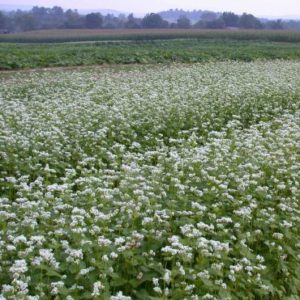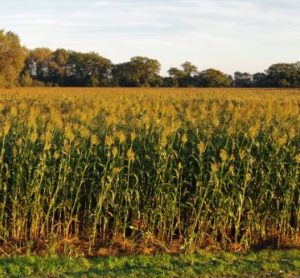Alfalfa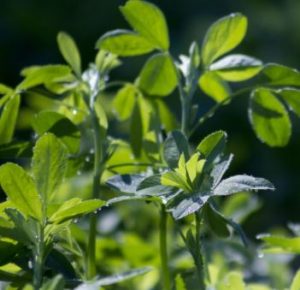
Medicago sativa
- Perennial legume
- Highly nutritious
- Fixes 150 -250 lbs nitrogen per acre
- Deep-rooted and drought-tolerant
- Graze, or cut, to 2”. (Delay 5 days after any freeze damage.)
- Hay at early bloom
- Cold hardy—after the seedling stage
- Germ. Temp.: 40F
- Broadcast @
- 12# (dryland)-20# (irrigated) / acre
- 5# / 1000 sq. ft.
- Depth: 0.25 – 0.5 in.
- Tolerates pH 6.0-8.2
- Plant in Fall, or after the last Spring freeze
- Yield reduces in heat (over 95 degrees)
Alyssum
Lobularia maritima (Alyssum maritimum) is a spring annual with an upright habit to 1.5′.
- Easy to incorporate by mowing or tillage
- Attracts Beneficial Insects: Lacewings, parasitic wasps, syrphid flies, and tachinid flies.
- Broadcast @
- 1# / acre
- 5oz / 1000 sq. ft.
- Depth: 0.125 – 0.25 in.
- Quick Establishment when planted in spring
- Good Weed Suppression
- Great addition to cut flower gardens
Annual Ryegrass
Lolium multiflorum is a winter annual cereal with an upright habit to 6 feet.
- Minimum Germination Temperature is 40F
- Hardy through Zone 6
- Broadcast @ 30 lb/acre, 1 lb/square foot at 0-.5″ depth
- Produces 2,000-9,000 lbs. biomass per acre
- Excellent Nitrogen scavenger
- Improves soil structure
- Readily reseeds
- Weed suppression
- Tolerant of shade and waterlogged soil
Beneficial Insect Mix 
A mix made for spring sowing of Phacelia (phacelia tanacetifolia), White Yarrow (achilliea millefolium), Sweet Alyssum (lobularia maritima, Alyssum maritima), California Poppy (Eschscholzia californica), Baby’s Breath (Gypsophila), Bachelor’s Buttons (Centaurea cyanus), Persian Clover (Trifolium resupinatum), Frontier Balansa Clover (Trifolium michelianum), New Zealand White Clover (Trifolium repens), Red Clover (Trifolium pratense), Crimson Clover (Trifolium incarnatum), Creeping Red Fescue (Festuca rubra), Hard Fescue (Festuca brevipila), Broadleaf Birdsfood Trefoil (Lotus corniculatus), Campeda Subclover (Trifolium subterraneum).
- Broadcast at 30 lbs per acre or 1 lb per 1000 square feet at a depth of .25 – .5″
Organic Cayuse Oats
Avena sativa is a winter annual cereal with an upright habit to 5 feet.
- Broadcast at 125 lbs/acre or 2 lbs/1000 square foot at a depth of .5 – 1.5″
- Produces 2,000 – 10,000 lbs. biomass per acre
- Nitrogen scavenger
- Quick establishment when planted in early fall
- Excellent weed suppression
Buckwheat
Fagopyrum esculentum is a summer annual with an upright habit to 3 feet.
- It has a minimum germination temperature of 50F
- Broadcast at 75 lbs per acre or 2.5 lbs per 1000 square feet at a depth of .5 to 1.5″
- Attracts beneficial insects
- Readily reseeds
- Quick establishment when planted in spring/summer
- Excellent weed suppression
Crimson Clover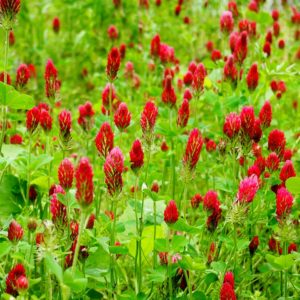
Trifolium incarnatum is an annual legume with a semi upright habit to 18 inches.
- Broadcast at 30 lbs. per acre or 2 lb. per 1000 square feet at depth of .25 – .5″
- Hardy through Zone 7
- Fixes up 70 to 100 lbs. of Nitrogen per acre
- Easy to incorporate by hand, mowing or tilling
- Quick Establishment when planted in early fall
- Readily Reseeds
Starfire Red Clover 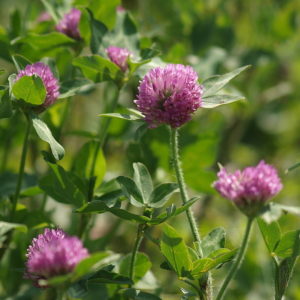
Trifolium pratense is a spring biennial with an upright habit.
- Broadcast at 12 lb. per acre or 1.5 lb per 1000 square feet at a depth of 25″
- Hardy through Zone 4
- Attracts beneficial insects
- Widely adapted to many soil types
- Palatable forage
- Excellent soil conditioner
New Zealand White Clover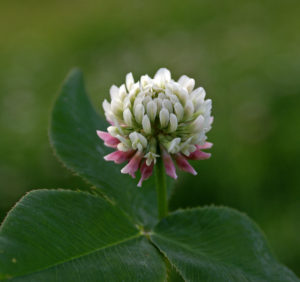
Trifolium repens is a perennial legume that has a spreading habit of up to 18 inches and is best when mixed with perennial grasses. It can be difficult to kill, and is recommended as a permanent ground cover.
- Broadcast at 12 lbs. per acre or .5 lbs. per 1000 square feet and a depth of .25 – .5 inches
- Fixes 80 to 100 lbs. Nitrogen per acre
- Palatable forage
- Hardy through Zone 4
- Tolerant of shade and drought
Daikon Radish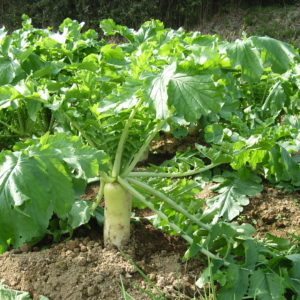
Raphanus sativus is an annual brassica that is good for winter cattle forage that grows 18 to 24 inches above ground and below ground.
- Broadcast at 10 lbs. per acre and .25 lbs. per 1000 square feet
- Produces 5,000 lbs. biomass per acre and 2,000 lbs. per acre below ground
- Minimum germination temperature is 40F
- Hardy through Zone 7
- Winterkills at 20F
- Seed late August to allow 6 weeks of growth before the first frost
- Nitrogen, Phosphorous & Potassium accumulator
- Weed supressor
- Bio-driller: improves soil porosity
Lorrane Fava Bean 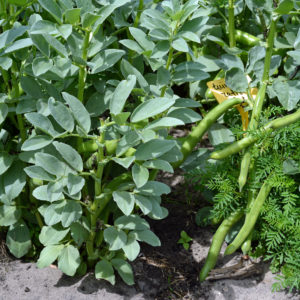
Vicia faba is a winter annual legume with a tall upright habit to six feet.
- Broadcast at 125 lbs. per acre and 3 lbs. per 1000 square feet at a depth of 1 – 3 inches
- Builds 7000 lbs. biomass per acre
- Fixes up to 140 lbs. Nitrogen per acre
- Hardy through Zone 7
- Taproot helps loosen compacted soils
- Incorporate mechanically: Becomes fibrous in late spring
- Tolerant of wet soils
Nemagone White Mustard
Brassica alba (Sinapsis alba, Brassica hirta) is an annual brassica with an upright habit to five feet tall.
- Broadcast at 20 – 25 lbs. per acre or .5 lbs. per 1000 square feet at a depth of .25 – .75 inches
- Builds 3,000 to 9,000 lbs. of biomass per acre
- Biofumigant – Suppresses nematodes (72-86%)
- Wait four to six weeks after incorporating before replanting. The biofumigation comes from the decomposing residues.
- Adds organic matter
- Immobilizes less Nitrogen than cereal crops
- Winterkills at 25F
Austrian Winter Pea 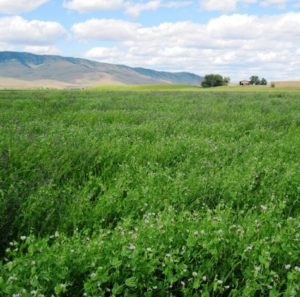
Pisum sativum is a winter annual legume with a climbing habit that is best when paired with cereal grains for support.
- Broadcast at 100 lbs per acre or 4 lbs per 1000 square feet at a depth of 1.5 – 3 inches
- Hardy through Zone 7
- Minimum germination temperature is 41F
- Fixes between 90 and 150 lbs of Nitrogen per acre
- Builds 4,000 to 5,000 lbs biomass per acre
Lacy Phacelia 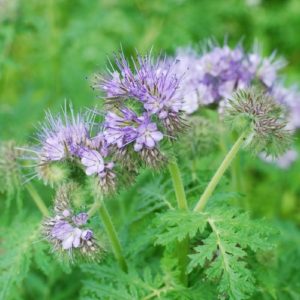
Phacelia tanacetifolia is a winter annual with a upright habit to three feet.
- Broadcast at 10 lbs. per acre or 1 oz. per 1000 square feet at a depth of .125 – .25 inches.
- Winterkills at 18F
- Hardy to Zone 8
- Excellent Nitrogen scavenger
- Improves soil structure
- Attracts Beneficial Insects: Excellent when planted next to Brassicas
- Tolerates drought
Organic Cereal rye/common vetch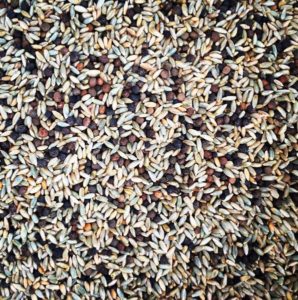
Secale cereale, Vicia sativa is an annual cereal and legume mix with an upright habit of up to 6 feet.
- Broadcast at 90 lbs per acre or 3.5 lbs per 1000 square feet at a depth of 0 – .5 inches
- Minimum germination temperature 38F
- Hardy through Zone 6
- Quick Establishment when planted in early fall
- Improves soil structure
- Adds organic matter
- Pest/weed suppressor
- Nitrogen fixer
- Readily reseeds
- Mow and Till directly after flowering
Sorghum-Sudan grass
Sorghum x drummondii is a summer annual with an upright habit to 12 feet.
- Broadcast at 50 lbs an acre or 1.5 lbs per 1000 square feet at a depth of .5 – 1 inches
- Minimum germination temperature 65F
- Quick establishment when planted in early summer
- Excellent Soil Builder, Breaks through compaction if mowed to 18” when crop reaches 3 – 4′ tall
- Excellent Nitrogen scavenger
- Biofumigant and nematicide
- Excellent weed supressor
- Tolerates heat and drought
- Incorporate by close mowing followed by tillage
Organic Bunker Triticale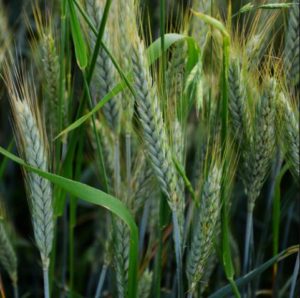
Triticosecale is a cross of wheat and cereal rye – a winter annual cereal with an upright habit to five feet.
- Broadcast at 75 lbs per acre or 3 pounds per 1000 square feet at a depth of .75 to 2 inches
- Minimum germination temperature is 40F
- Builds 3,000 to 10,000 lbs biomass per acre
- Quick establishment when planted in early fall
- Excellent weed suppresor
- Promotes drainage
- Good for forage/hay
- Improves soil structure
- Mow to 3” in spring and it will regrow
- Difficult to Incorporate; follow close mowing with tillage
Common Vetch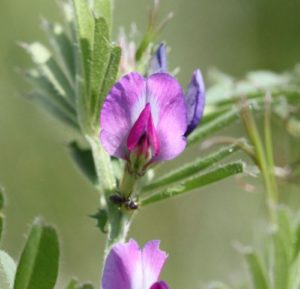
Vicia sativa is a winter annual legume with a climbing habit to 5 feet.
- Broadcast at 75 lbs per acre or 2 lbs per 1000 square feet at a depth of .25 – 1 inch
- Hardy through Zone 8
- Fixes 50 – 120 lbs Nitrogen per acre
- Incorporate Mechanically: Vetch is tolerant of mowing
- Excellent weed suppression

